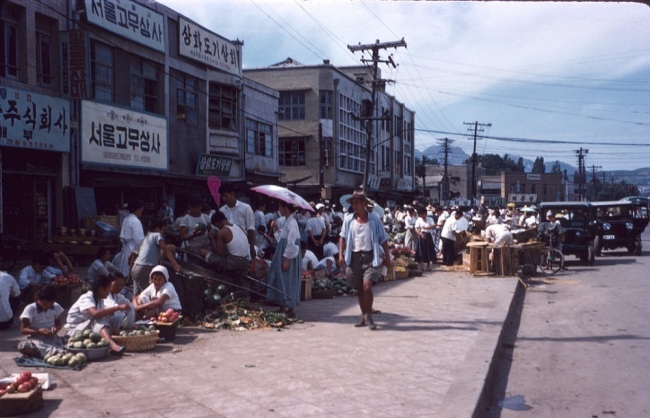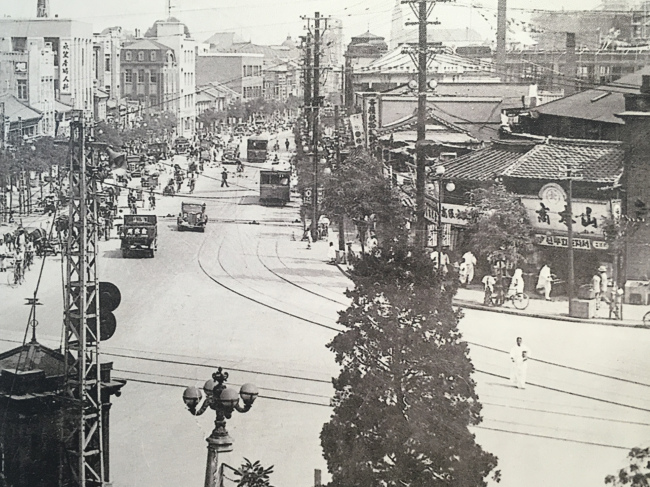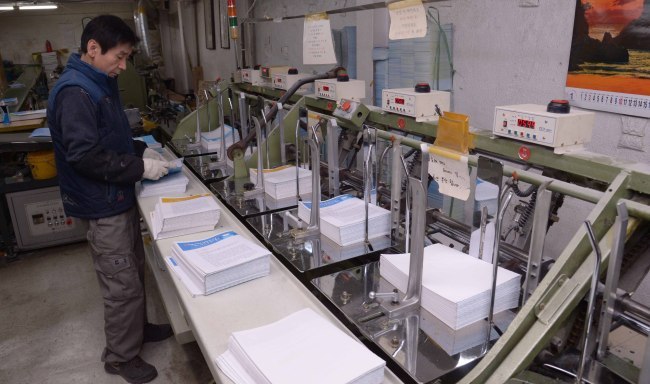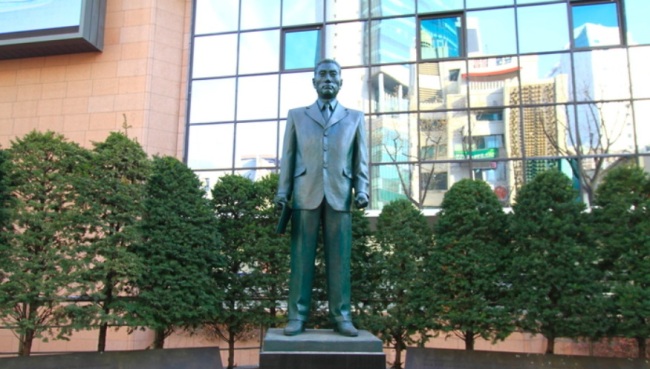[Weekender] Walking down the history of Euljiro
Decades-old “print shop avenue” in Euljiro to be reborn as creative hub for print business
By Kim Da-solPublished : July 6, 2018 - 16:56
Euljiro, some 3.5 kilometer road cutting through the heart of Seoul in Jung-gu, has a history that goes back to 1940s.
The area was called Gokanemachi under the Japanese Government General of Korea until 1946, when Koreans changed it to Eulji, named after General Eulji Mundeok who saved Korea from the invading Sui Dynasty in China.
Koreans tried to weaken the spirit of Chinese who formed a Chinatown in Euljiro in the 1940s by naming the area after a courageous figure.
The area was called Gokanemachi under the Japanese Government General of Korea until 1946, when Koreans changed it to Eulji, named after General Eulji Mundeok who saved Korea from the invading Sui Dynasty in China.
Koreans tried to weaken the spirit of Chinese who formed a Chinatown in Euljiro in the 1940s by naming the area after a courageous figure.

For decades, Euljiro has been a busy commercial district with large-scale markets.
Bangsan Wholesale Market, a traditional market that now mainly sells packaging and bakery materials, is one of Korea’s earliest form of all-you-can-find markets since 1945.
It was also called “Yankey Market” in its early days since the American soldiers stationed near Euljiro used to sell their canned food from the military at Bangsan Market. Since then, small retailers selling flour and candy settled there and began to form a wholesale marketplace.
Euljiro is also a neighborhood filled with stores selling materials from hardware to timber, paint, papering and lamps. These shops were set up when Koreans had to repair their houses after the Korean War ended in 1953.
Most of all, Euljiro is best known for print shops. Known as “print shop avenue,” Korea’s printing business began here in the mid-1910s.
When the first movie theater opened in Euljiro, shops that print movie posters and promotional flyers for those theaters began to form in the adjacent avenues in Euljiro and nearby Chungmuro area.
Bangsan Wholesale Market, a traditional market that now mainly sells packaging and bakery materials, is one of Korea’s earliest form of all-you-can-find markets since 1945.
It was also called “Yankey Market” in its early days since the American soldiers stationed near Euljiro used to sell their canned food from the military at Bangsan Market. Since then, small retailers selling flour and candy settled there and began to form a wholesale marketplace.
Euljiro is also a neighborhood filled with stores selling materials from hardware to timber, paint, papering and lamps. These shops were set up when Koreans had to repair their houses after the Korean War ended in 1953.
Most of all, Euljiro is best known for print shops. Known as “print shop avenue,” Korea’s printing business began here in the mid-1910s.
When the first movie theater opened in Euljiro, shops that print movie posters and promotional flyers for those theaters began to form in the adjacent avenues in Euljiro and nearby Chungmuro area.

Some of the first movie theaters include Kukdo Theater, which opened in 1913. Some of the major Korean films including Chunhyangjeon were played here, until it closed in 1999. The theater was turned into a premium hotel in 2007.
Unlike Kukdo Theater, Myungbo Theater is still operated as an art complex where it hosts various types of cultural events, especially for the elderly who reminiscence about the place’s 50-year-long history.
As of today, Euljiro has some 3,000 print shops that are still running, while up to 5,500 print shops were here during its heyday. Data from the city government shows that over 67 percent of printing companies in Korea are still located near Euljiro.
But with more shops closing down in recent years amid the advent of advanced technology and a paperless society, Seoul Mayor Park Won-soon in March announced 2020 Dasi-Sewoon project, a project to revitalize the area.
He said the project will give the decades-year-old Sewoon Market and nearby industrial complex a fresh, new look through renovation.
“Respecting old values, the city government decided to keep Seoul’s old but meaningful spots, instead of completely demolishing the area to construct new buildings,” said Seoul Mayor Park as he unveiled the plan.
Unlike Kukdo Theater, Myungbo Theater is still operated as an art complex where it hosts various types of cultural events, especially for the elderly who reminiscence about the place’s 50-year-long history.
As of today, Euljiro has some 3,000 print shops that are still running, while up to 5,500 print shops were here during its heyday. Data from the city government shows that over 67 percent of printing companies in Korea are still located near Euljiro.
But with more shops closing down in recent years amid the advent of advanced technology and a paperless society, Seoul Mayor Park Won-soon in March announced 2020 Dasi-Sewoon project, a project to revitalize the area.
He said the project will give the decades-year-old Sewoon Market and nearby industrial complex a fresh, new look through renovation.
“Respecting old values, the city government decided to keep Seoul’s old but meaningful spots, instead of completely demolishing the area to construct new buildings,” said Seoul Mayor Park as he unveiled the plan.

By 2020, Euljiro will be reborn as a creative hub of the print business, with the establishment of print-related technology center and the print research lab, according to Seoul City.
Besides the vibrant industrial scene in Euljiro, some of Korea’s historical sites can be found in the neighborhood.
Admiral Yi Sun-sin was born in Inhyun-dong, Euljiro, in 1545 where he spent his childhood as the first son among four boys. A statue of the famous war hero is located in Gwanghwamun, not so far from where his birthplace is.
Across from the street of Yi Sun-sin’s birthplace, there was a royal hall from Joseon Dynasty called YoungheeJeon. It was used as a royal shrine where several kings’ portraits were enshrined. During the Japanese colonization period, Japanese officials set up Bonjeong Police Station here, which is now Seoul Jungbu Police Station.
Besides the vibrant industrial scene in Euljiro, some of Korea’s historical sites can be found in the neighborhood.
Admiral Yi Sun-sin was born in Inhyun-dong, Euljiro, in 1545 where he spent his childhood as the first son among four boys. A statue of the famous war hero is located in Gwanghwamun, not so far from where his birthplace is.
Across from the street of Yi Sun-sin’s birthplace, there was a royal hall from Joseon Dynasty called YoungheeJeon. It was used as a royal shrine where several kings’ portraits were enshrined. During the Japanese colonization period, Japanese officials set up Bonjeong Police Station here, which is now Seoul Jungbu Police Station.

In front of the Industrial Bank of Korea located in Euljiro-2ga, there is a statue of a Korean nationalist Na Seok-ju, who made attacks in 1926 inside the Oriental Development Company -- an organization set up in 1908 by Imperial Japan as part of its imperial expansion and development of its colonies.
After throwing a grenade, he ran after other high-level employees inside the building, but his grenade did not work. As more Japanese officers closed in on him, he shot himself three times in the chest.
While some say that Na should be labeled a terrorist for having attacked non-military targets, he was given posthumous honors and acknowledgment as a nationalist hero.
On his statue located in front of the IBK building, it reads “Na Seok-ju (1892-1926) is beloved by the people of Korea for his heroic struggle to regain the sovereignty and economic independence of Korea, forcibly taken by the Japanese colonialists.”
By Kim Da-sol
(ddd@heraldcorp.com)
After throwing a grenade, he ran after other high-level employees inside the building, but his grenade did not work. As more Japanese officers closed in on him, he shot himself three times in the chest.
While some say that Na should be labeled a terrorist for having attacked non-military targets, he was given posthumous honors and acknowledgment as a nationalist hero.
On his statue located in front of the IBK building, it reads “Na Seok-ju (1892-1926) is beloved by the people of Korea for his heroic struggle to regain the sovereignty and economic independence of Korea, forcibly taken by the Japanese colonialists.”
By Kim Da-sol
(ddd@heraldcorp.com)



















![[Today’s K-pop] Treasure to publish magazine for debut anniversary](http://res.heraldm.com/phpwas/restmb_idxmake.php?idx=642&simg=/content/image/2024/07/26/20240726050551_0.jpg&u=)